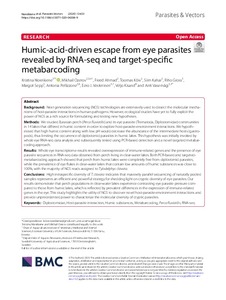Humic-acid-driven escape from eye parasites revealed by RNA-seq and target-specific metabarcoding
Riho Gross; Freed Ahmad; Margot Sepp; Antonia Pellizzone; Toomas Kõiv; Siim Kahar; Veljo Kisand; Mikhail Ozerov; Eero J. Vesterinen; Kristina Noreikiene; Anti Vasemägi
Humic-acid-driven escape from eye parasites revealed by RNA-seq and target-specific metabarcoding
Riho Gross
Freed Ahmad
Margot Sepp
Antonia Pellizzone
Toomas Kõiv
Siim Kahar
Veljo Kisand
Mikhail Ozerov
Eero J. Vesterinen
Kristina Noreikiene
Anti Vasemägi
BMC
Julkaisun pysyvä osoite on:
https://urn.fi/URN:NBN:fi-fe2021042827084
https://urn.fi/URN:NBN:fi-fe2021042827084
Tiivistelmä
Background: Next generation sequencing (NGS) technologies are extensively used to dissect the molecular mechanisms of host-parasite interactions in human pathogens. However, ecological studies have yet to fully exploit the power of NGS as a rich source for formulating and testing new hypotheses.
Methods: We studied Eurasian perch (Perca fluviatilis) and its eye parasite (Trematoda, Diplostomidae) communities in 14 lakes that differed in humic content in order to explore host-parasite-environment interactions. We hypothesised that high humic content along with low pH would decrease the abundance of the intermediate hosts (gastropods), thus limiting the occurrence of diplostomid parasites in humic lakes. This hypothesis was initially invoked by whole eye RNA-seq data analysis and subsequently tested using PCR-based detection and a novel targeted metabarcoding approach.
Results: Whole eye transcriptome results revealed overexpression of immune-related genes and the presence of eye parasite sequences in RNA-seq data obtained from perch living in clear-water lakes. Both PCR-based and targeted-metabarcoding approach showed that perch from humic lakes were completely free from diplostomid parasites, while the prevalence of eye flukes in clear-water lakes that contain low amounts of humic substances was close to 100%, with the majority of NGS reads assigned toTylodelphys clavata.
Conclusions: High intraspecific diversity ofT. clavataindicates that massively parallel sequencing of naturally pooled samples represents an efficient and powerful strategy for shedding light on cryptic diversity of eye parasites. Our results demonstrate that perch populations in clear-water lakes experience contrasting eye parasite pressure compared to those from humic lakes, which is reflected by prevalent differences in the expression of immune-related genes in the eye. This study highlights the utility of NGS to discover novel host-parasite-environment interactions and provide unprecedented power to characterize the molecular diversity of cryptic parasites.
Kokoelmat
- Rinnakkaistallenteet [19207]
